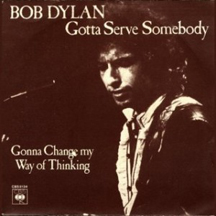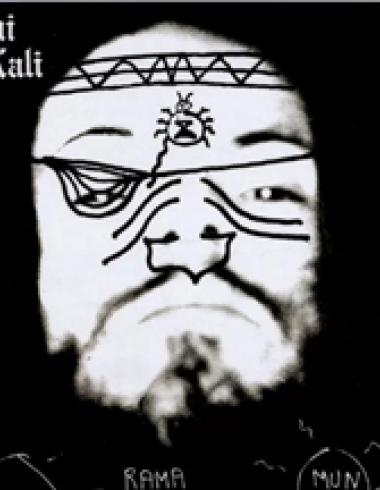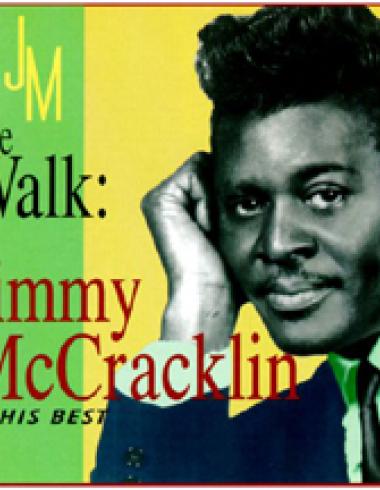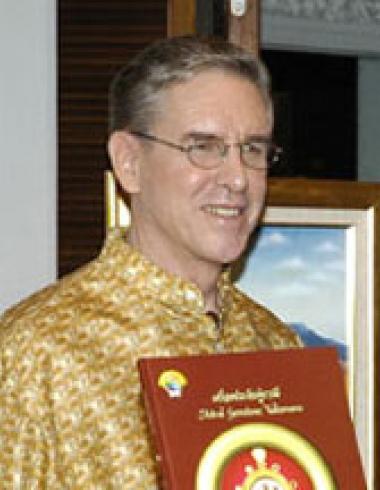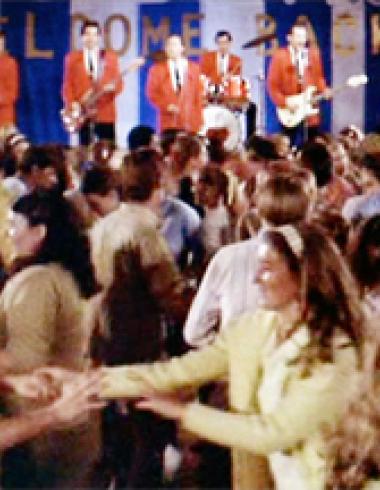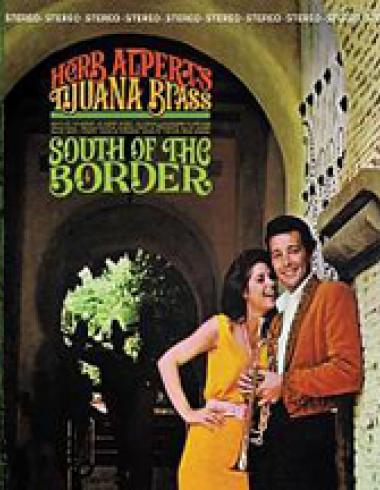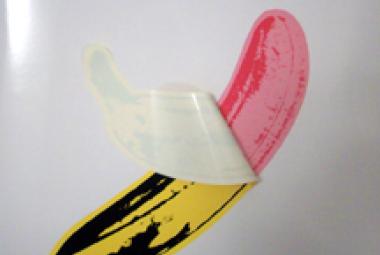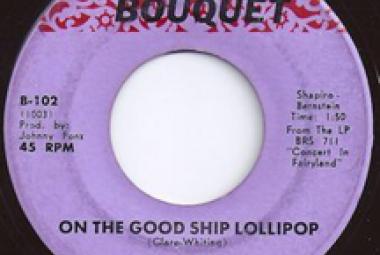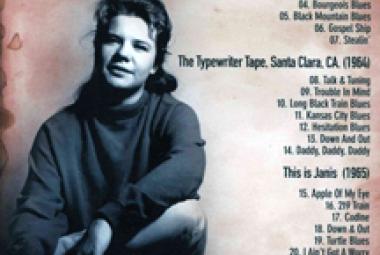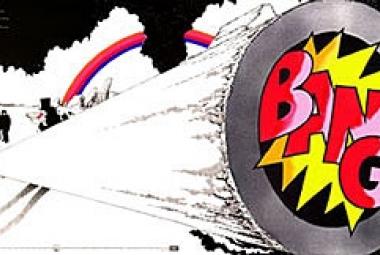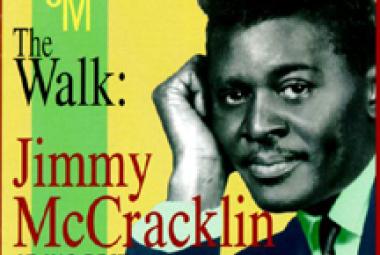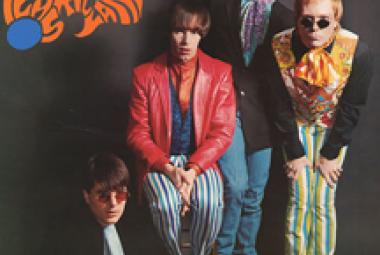One glance at the above album cover for Saved proves beyond doubt that Bob Dylan was serious with his Christian period. The songs were serious as well: “Covenant Woman”, “Pressing On”, “Saving Grace”, “Are You Ready”, etc. The opening track, “A Satisfied Mind” is a rare cover by Dylan of someone else’s song; “A Satisfied Mind” dates from the mid-1950’s and was first recorded by Porter Wagoner. (Interestingly, the debut solo album by folksinger Hamilton Camp, Paths of Victory – which, at the insistence of Elektra Records, has seven covers of mostly obscure Bob Dylan songs – also includes a cover of “A Satisfied Mind”). The album art is by a veteran in that field, Tony Wright; two of his designs – for Traffic’s The Low Spark of High Heeled Boys (1971) and Steve Winwood’s Arc of a Diver (1980) – were named among the 100 Greatest Album Covers by Rolling Stone magazine.
In order to downplay the Christian message in the Saved album (if that’s possible), the cover painting was later replaced with a painting of Dylan in performance.
Saved was the middle album of Dylan’s so-called Christian trilogy (the three albums were released within a two-year period); but really (as is usual with Dylan), it wasn’t quite that simple.
* * *
For one thing, Bob Dylan often used Biblical imagery in his songs. One obvious example is one of his loveliest songs, “Knockin’ on Heaven’s Door”, which is taken from the soundtrack of Pat Garrett & Billy the Kid (1973). On his very first album, Bob Dylan (1962), the first song on Side 2 is “Gospel Plow”.
The title song on Highway 61 Revisited (1965) – the album which includes Dylan’s signature song “Like a Rolling Stone” – includes a novel take on the Biblical story of Abraham, when God told him to kill his newborn, long-promised son Isaac. (I had no idea what the title meant, really, until I moved to Mississippi and found that U.S. Highway 61 runs through the heart of the Delta Blues country. The city of Brookhaven, where I first lived and worked, is located on U.S. Highway 51, and I also knew about a more obscure song by Bob Dylan called “Highway 51”). Here are the lyrics for the first verse of “Highway 61 Revisited”:
Oh God said to Abraham, “Kill me a son”
Abe says, “Man, you must be puttin’ me on”
God say, “No.” Abe say, “What?”
God say, “You can do what you want Abe, but
The next time you see me comin’ you better run”
Well Abe says, “Where do you want this killin’ done?”
God says, “Out on Highway 61”
In the late 1970’s though, Dylan’s music went beyond imagery into true belief.
* * *
The best known of Bob Dylan’s Christian albums was the previous album Slow Train Coming, which produced the hit song “Gotta Serve Somebody”, the topical song “Slow Train” (also relatively rare by this point in Dylan’s career) and the charming children’s song “Man Gave Names to All the Animals” – this one ends abruptly before naming the snake (and Dylan later verified that he meant the one in the Garden of Eden). But several of the songs didn’t pull any punches or seek shelter in allegory, notably “Precious Angel”, “When You Gonna Wake Up” and “When He Returns”.
Following Saved, Shot of Love reintroduced secular themes into his music; but “Property of Jesus” is the center song on the first side. Additionally, Infidels was viewed as a return to the “old” Bob Dylan by most; however, the title clearly has religious connotations – and might even represent a dagger toward his critics. “Man of Peace” on this album – as in, “sometimes Satan comes as a man of peace” – could easily have fit onto one of the earlier albums.
Wikipedia says that “Infidels is seen as his return to secular music, following a conversion to Christianity, three evangelical gospel records, and a subsequent return to a secular, culturally Jewish lifestyle” (whatever that is supposed to mean).
* * *
Bob Dylan’s Christian hit song “Gotta Serve Somebody” is a litany of people in various fields and various places in their lives who have to make that choice. In this song, Dylan shows that he hasn’t lost his sense of humor: In the final verse, he lists names instead, including two of his own nicknames – “You may call me Bobby, you may call me Zimmy” (taken from his original surname Zimmerman) – and then two from a comedy shtick of the day – “You may call me R.J., you may call me Ray” – that is, the character Ray J. Johnson, Jr. that was created by Bill Saluga.
But this is no easy theology. The chorus of this song includes the lines, “Well, it may be the Devil or it may be the Lord / But you’re gonna have to serve somebody”.
One of the verses in another song on the album, “Precious Angel” seems to echo the dialogue between Jesus and the Samaritan woman at the well; it lays it out in no uncertain terms:
Sister, lemme tell you about a vision I saw
You were drawing water for your husband, you were suffering under the law
You were telling him about Buddha, you were telling him about Mohammed
in the same breath
You never mentioned one time the Man who came and died a criminal’s death
* * *
Trying to uncover what was behind this dramatic change in Bob Dylan’s music was hard enough to figure out at the time, and there are several competing stories on the Internet from people who often seem to have an agenda. There is a film out there called Inside Bob Dylan’s Jesus Years: Busy Being Born Again, books such as Restless Pilgrim: The Spiritual Journey of Bob Dylan, and numerous magazine articles.
By all accounts, however, Bob Dylan has never renounced his “born again” Christian conversion, despite numerous reports that obliquely suggest otherwise. Dylan is well known for producing less than consistent quotes over the years, and that has only added to the confusion.
For instance, in Wikipedia, Dylan is quoted in 1984 as distancing himself from the “born again” label: “I’ve never said I’m born again. That’s just a media term. I don’t think I’ve been an agnostic. I’ve always thought there’s a superior power, that this is not the real world and that there’s a world to come.”
In a 1984 interview, Bob Dylan says: “The songs that I wrote for the Slow Train album [frightened me] . . . I didn’t plan to write them . . . I didn’t like writing them. I didn’t want to write them.”
Wikipedia highlights another Dylan quote from 1997: “Here’s the thing with me and the religious thing. This is the flat-out truth: I find the religiosity and philosophy in the music. I don’t find it anywhere else. Songs like ‘Let Me Rest on a Peaceful Mountain’ or ‘I Saw the Light’ — that’s my religion. I don’t adhere to rabbis, preachers, evangelists, all of that. I’ve learned more from the songs than I’ve learned from any of this kind of entity. The songs are my lexicon. I believe the songs.”
* * *
Bob Dylan was still a polarizing figure in the late 1970’s, and Slow Train Coming alienated at least as many fans as it attracted. Still, in its first year, the album outsold two of Dylan’s best albums, Blonde on Blonde and Blood on the Tracks in their first years; and “Gotta Serve Somebody” was a #24 hit single – his highest placement in the Billboard Hot 100 since “Knockin’ on Heaven’s Door” in 1973.
Since 2012 marked the 50th anniversary of the release of Bob Dylan’s first album, Bob Dylan, a re-examination of his multi-faceted career was taking place. Al Kasha, who takes credit for leading Dylan to Jesus, is a Messianic Jew (and that might be the best way to describe Dylan himself actually). He knew Dylan from his earliest days at Columbia Records, where he was their youngest record producer in 1960. On the blog Godreports, Kasha remarks that Dylan wrote the songs on Slow Train Coming at Kasha’s Beverly Hills home. Al Kasha also discusses Dylan’s 2012 album, Tempest (his most recent studio album): “I am absolutely thrilled that Bob has shown through this new record that he has never lost God’s calling in life. He’s never given up. I get upset when people think that he has because you don’t write all these songs just out there. It takes time to write them and they’re all about Christ, so I’ve said this in the past — the media has hurt rather than helped him.”
* * *
Bob Dylan has also released a Christmas album, Christmas in the Heart. Wikipedia mentions a 2009 interview with Bill Flanagan when he was promoting the album: “Flanagan commented on the ‘heroic performance’ Dylan gave of ‘O Little Town of Bethlehem’ and that he ‘delivered the song like a true believer’. Dylan replied: ‘Well, I am a true believer.’”
* * *
One clue to what was happening with Bob Dylan occurred about six months before Slow Train Coming was released in November 1979; as reported by Wikipedia: “Before the album was completed, Patty Valentine had brought a defamation-of-character suit against Dylan, regarding the song ‘Hurricane’ from Desire; on May 22, [1979,] while giving a pre-trial deposition in his defense, Dylan was asked about his wealth. ‘You mean my treasure on earth?’ replied Dylan. He was asked about the identity of the ‘fool’ in ‘Hurricane’. Dylan said the ‘fool’ was ‘whoever Satan gave power to . . . whoever was blind to the truth and was living by his own truth’. Five days later, Dylan’s pre-trial statement was reported in the Washington Post, which also interviewed Kenn Gulliksen, who revealed to the paper that Dylan had joined the Vineyard Christian Fellowship.”
Wikipedia mentions that the organization now known as the Association of Vineyard Churches (which was founded by Gulliksen) was formed in part by Christian contemporary music pioneers that I mentioned in my last post: “The first local church started when Kenn Gulliksen brought together two Bible studies, both meeting at the houses of singer/songwriters: Larry Norman and Chuck Girard [a founder of early CCM band Love Song]. In early 1975, thirteen groups met at the Beverly Hills Women’s Club. These Bible studies, and others like them, were attended by many popular actors/actresses and musicians including Bob Dylan.” Dylan also attended the Calvary Chapel discipleship courses in Southern California.
* * *
Bob Dylan himself reports that someone threw a silver cross on the stage during a concert in San Diego in November 1978, leading directly to his conversion to Christ. It was much more dramatic than I had ever imagined. Again from Wikipedia, Dylan recalls in a 1979 interview: “‘Towards the end of the show someone out in the crowd . . . knew I wasn’t feeling too well. I think they could see that. And they threw a silver cross on the stage. Now usually I don’t pick things up in front of the stage. Once in a while I do. Sometimes I don’t. But I looked down at that cross. I said, “I gotta pick that up.” So I picked up the cross and I put it in my pocket. . . . And I brought it backstage and I brought it with me to the next town, which was out in Arizona. . . . I was feeling even worse than I’d felt when I was in San Diego. I said, “Well, I need something tonight.” I didn’t know what it was. I was used to all kinds of things. I said, “I need something tonight that I didn’t have before.” And I looked in my pocket and I had this cross.’
“Dylan believed he had experienced a vision of Christ in his Tucson hotel room. ‘Jesus did appear to me as King of Kings, and Lord of Lords,’ he’d later say. ‘There was a presence in the room that couldn’t have been anybody but Jesus. . . . Jesus put his hand on me. It was a physical thing. I felt it. I felt it all over me. I felt my whole body tremble. The glory of the Lord knocked me down and picked me up.’
“[Clinton] Heylin writes that ‘his state of mind may well have made him susceptible to such an experience. Lacking a sense of purpose in his personal life since the collapse of his marriage, he came to believe that, when Jesus revealed Himself, He quite literally rescued him from an early grave.’
“‘[Dylan’s] conversion wasn’t one of those things that happens when an alcoholic goes to Alcoholics Anonymous,’ David Mansfield, one of Dylan’s band members and fellow born-again Christian, would later say. ‘The simplest explanation is that he had a very profound experience which answered certain lifelong issues for him.’ . . .
“Dylan wasn’t alone in his religious awakening. Band members Steven Soles and David Mansfield had already joined the Vineyard [Christian] Fellowship, a Christian organization introduced to them by T-Bone Burnett. Helena Springs, one of the singers in the band, was brought up Christian and still practiced her faith. Dylan was also romantically linked with Mary Alice Artes; raised as a Christian, she had strayed from her faith only to return to it after joining the Vineyard Fellowship (without the influence of Burnett, Soles, or Mansfield).”
* * *
Wikipedia also reports that for the past 20 years, Bob Dylan has been a supporter of Chabad Lubavitch movement, a prominent Orthodox Jewish group that I remember well from my days in New York in the early 1990’s for their subway ads reminding riders of upcoming Jewish holidays and festivals. Dylan has also participated in the Bar Mitzvahs of his sons and attended other Jewish services over the years.
* * *
Returning to the albums, Slow Train Coming and the albums that followed it are notable for the all-star assistance that Dylan received in putting them together. Bob Dylan heard the Dire Straits hit single “Sultans of Swing” and contacted guitarist and lead vocalist Mark Knopfler about working on an album together.
Dylan also asked Jerry Wexler to produce the record; a genuine legend in the recording industry, he is the man who coined the term “rhythm and blues”. Wexler recalls the encounter (as taken from Wikipedia): “Naturally, I wanted to do the album in Muscle Shoals — as Bob did — but we decided to prep it in L.A., where Bob lived. That’s when I learned what the songs were about: born-again Christians in the old corral. . . . I liked the irony of Bob coming to me, the Wandering Jew, to get the Jesus feel. . . . [But] I had no idea he was on this born-again Christian trip until he started to evangelize me. I said, ‘Bob, you’re dealing with a sixty-two-year-old confirmed Jewish atheist. I’m hopeless. Let’s just make an album.’”
For Shot of Love, other players include ex-Beatle Ringo Starr on drums, current Rolling Stone Ronnie Wood on guitar, bass guitarist Donald “Duck” Dunn – formerly of Booker T and the MG’s and also the Blues Brothers Band – and veteran sessionman Danny “Kootch” Kortchmar on guitar and electric guitar. Bumps Blackwell, who produced most of Little Richard’s most indelible songs, produced the title song “Shot of Love”.
Infidels marked a change in musical direction with the addition of Jamaican rhythm section Sly & Robbie; Mark Knopfler returned for that album, and the personnel also included Mick Taylor, who was with the Rolling Stones from 1969 to 1974.
* * *
For a time, Bob Dylan only sang his gospel songs in concert; he was often heckled, but that certainly wasn’t the first time that happened to him. When his older material was brought back into the performances, there were changes in the lyrics in some cases. In “Tangled up in Blue”, the mysterious woman who originally quoted “an Italian poet from the 13th Century” began quoting from the Bible; sometimes it was the Book of Matthew, but eventually Dylan settled on Jeremiah 31:31 – “Behold, the days come, sayeth the Lord, that I will make a new covenant with the house of Israel, and with the house of Judah.” This Biblical quotation was included in the liner notes for Saved.
Another time (from Wikipedia), Dylan connected up some of his early songs with the Second Coming: “You know we’re living in the end times. . . . The scriptures say, ‘In the last days, perilous times shall be at hand. Men shall become lovers of their own selves. Blasphemous, heavy and highminded.’ . . . Take a look at the Middle East. We’re heading for a war. . . . I told you ‘The Times They Are A-Changin’’ and they did. I said the answer was ‘Blowin’ in the Wind’, and it was. I’m telling you now Jesus is coming back, and He is! And there is no other way of salvation. . . . Jesus is coming back to set up His Kingdom in Jerusalem for a thousand years.”
* * *
There was a noticeable dip in the ratings given by rock critics of Bob Dylan’s Christian recordings. That was not true so much for Slow Train Coming – Robert Christgau of the Village Voice gave the album a B+ and wrote: “The lyrics are indifferently crafted. Nevertheless, this is his best album since Blood on the Tracks. The singing is passionate and detailed.” Allmusic and Rolling Stone both rated the album ***.
For Saved, the Rolling Stone rating stood, but Allmusic gave the album only **, and Christgau scored it as C+. Entertainment Weekly showed a C–. Shot of Love had ** from both Rolling Stone and Allmusic; Christgau and Entertainment Weekly showed B–.
With Infidels though, all was forgiven: Rolling Stone and Allmusic were both at ****.
* * *
To put these ratings in context, Self Portrait (1970) is the only Bob Dylan album to get just ** before Saved, other than some live albums (Allmusic shows low ratings for most of the Rolling Stones live albums also). To this day, no one seems to understand Self Portrait – I certainly don’t. The music seems as off-putting as the splashes of color in the cover art. The first few times I played it, I really only enjoyed the live version of “Like a Rolling Stone”; I have heard several others since that I enjoy more. Some years later, the opening track “All the Tired Horses” stood out, but probably only because I couldn’t discern a hint of Bob Dylan anywhere in the song.
* * *
There is a Bob Dylan album that scores even lower in Allmusic, and here I need to put on my “Under Appreciated” hat – the 1973 release Dylan yields just *. Allmusic mentions that this LP is “[c]ommonly regarded as the worst album in Bob Dylan’s catalog”. The album is described in both Rolling Stone Record Guide and Allmusic as a collection of outtakes from Self Portrait – i.e., songs that didn’t make the cut for that head-scratcher – and that just sent chills up my spine. As I recall, it was also the last release on Columbia Records before Bob Dylan jumped ship to Asylum Records; and record companies are often spiteful in such cases, untold millions of dollars of earnings for the corporation notwithstanding.
Dylan is a recent rescue from Katrina, however, and I found it surprisingly easy to listen to. The album is entirely cover songs, many of them quite familiar; and if Dylan’s performance of Joni Mitchell’s “Big Yellow Taxi” leaves no impression at all, that is not true of the lesser known songs.
The opening track, a traditional folk song called “Lily of the West” is beautifully performed; and the album is well worth owning for that song alone. Personally I am at least as big a fan of Bob Dylan as a folksinger as I am of Bob Dylan as a rocker, and this song was a welcome return to the performances that I remember so well from his early albums.
* * *
Some of the criticism of Dylan’s Christian albums is quite harsh. Wikipedia mentions: “Critic Charles Shaar Murray wrote, ‘Bob Dylan has never seemed more perfect and more impressive than on this album. He has also never seemed more unpleasant and hate-filled.’ Greil Marcus wrote, ‘Dylan’s received truths never threaten the unbeliever, they only chill the soul’ and accused Dylan of ‘sell[ing] a prepackaged doctrine he’s received from someone else’.”
For what it’s worth, a 2013 readers’ poll in Rolling Stone magazine ranked “Gotta Serve Somebody” as Bob Dylan’s second worst song, with “Man Gave Names to All the Animals” as the fourth worst.
The Wikipedia article on Slow Train Coming also states (with no footnotes), in apparent violation of their NPOV (neutral point of view) policy: “In a year when Van Morrison and Patti Smith released their own spiritual works in Into the Music and Wave, respectively, Dylan’s album seemed vitriolic and bitter in comparison.” Neither album is particularly Christian, from what I can tell; the title track of the Patti Smith album “Wave” is dedicated to the nearly forgotten Pope John Paul I, but evidently only because it was recorded during his brief papacy. Also, Patti Smith’s previous album Easter, as might be expected from the title, has more Christian imagery; and Smith opened her acclaimed debut album Horses with a spoken-word introduction that could easily be described as “vitriolic and bitter”: “Jesus died for somebody’s sins, but not mine”.
* * *
Why did Bob Dylan quit recording Christian albums if he retains his Christian beliefs? There are any number of explanations: Many Christian recording artists perform all or mostly secular music, the drive to evangelize that attends a powerful conversion often fades after a while, Dylan might have said all that he felt that he needed to say, etc.
One factor is likely that all of this criticism directed at Bob Dylan stung – he is not as above it all as it might appear. A quotation from Wikipedia that I read some months ago that is no longer in the article on Infidels states: “It has been reported that reviews like these of Dylan’s religious works depressed the musician profoundly, inspiring Dylan’s comment at one concert that he was only referred to as a ‘prophet’ when he was a ‘secular prophet’ (paraphrased).”
(August 2014)
One glance at the above album cover for Saved proves beyond doubt that Bob Dylan was serious with his Christian period. The songs were serious as well: “Covenant Woman”, “Pressing On”, “Saving Grace”, “Are You Ready”, etc. The opening track, “A Satisfied Mind” is a rare cover by Dylan of someone else’s song; “A Satisfied Mind” dates from the mid-1950’s and was first recorded by Porter Wagoner. (Interestingly, the debut solo album by folksinger Hamilton Camp, Paths of Victory – which, at the insistence of Elektra Records, has seven covers of mostly obscure Bob Dylan songs – also includes a cover of “A Satisfied Mind”). The album art is by a veteran in that field, Tony Wright; two of his designs – for Traffic’s The Low Spark of High Heeled Boys (1971) and Steve Winwood’s Arc of a Diver (1980) – were named among the 100 Greatest Album Covers by Rolling Stone magazine.
In order to downplay the Christian message in the Saved album (if that’s possible), the cover painting was later replaced with a painting of Dylan in performance.
Saved was the middle album of Dylan’s so-called Christian trilogy (the three albums were released within a two-year period); but really (as is usual with Dylan), it wasn’t quite that simple.
* * *
For one thing, Bob Dylan often used Biblical imagery in his songs. One obvious example is one of his loveliest songs, “Knockin’ on Heaven’s Door”, which is taken from the soundtrack of Pat Garrett & Billy the Kid (1973). On his very first album, Bob Dylan (1962), the first song on Side 2 is “Gospel Plow”.
The title song on Highway 61 Revisited (1965) – the album which includes Dylan’s signature song “Like a Rolling Stone” – includes a novel take on the Biblical story of Abraham, when God told him to kill his newborn, long-promised son Isaac. (I had no idea what the title meant, really, until I moved to Mississippi and found that U.S. Highway 61 runs through the heart of the Delta Blues country. The city of Brookhaven, where I first lived and worked, is located on U.S. Highway 51, and I also knew about a more obscure song by Bob Dylan called “Highway 51”). Here are the lyrics for the first verse of “Highway 61 Revisited”:
Oh God said to Abraham, “Kill me a son”
Abe says, “Man, you must be puttin’ me on”
God say, “No.” Abe say, “What?”
God say, “You can do what you want Abe, but
The next time you see me comin’ you better run”
Well Abe says, “Where do you want this killin’ done?”
God says, “Out on Highway 61”
In the late 1970’s though, Dylan’s music went beyond imagery into true belief.
* * *
The best known of Bob Dylan’s Christian albums was the previous album Slow Train Coming, which produced the hit song “Gotta Serve Somebody”, the topical song “Slow Train” (also relatively rare by this point in Dylan’s career) and the charming children’s song “Man Gave Names to All the Animals” – this one ends abruptly before naming the snake (and Dylan later verified that he meant the one in the Garden of Eden). But several of the songs didn’t pull any punches or seek shelter in allegory, notably “Precious Angel”, “When You Gonna Wake Up” and “When He Returns”.
Following Saved, Shot of Love reintroduced secular themes into his music; but “Property of Jesus” is the center song on the first side. Additionally, Infidels was viewed as a return to the “old” Bob Dylan by most; however, the title clearly has religious connotations – and might even represent a dagger toward his critics. “Man of Peace” on this album – as in, “sometimes Satan comes as a man of peace” – could easily have fit onto one of the earlier albums.
Wikipedia says that “Infidels is seen as his return to secular music, following a conversion to Christianity, three evangelical gospel records, and a subsequent return to a secular, culturally Jewish lifestyle” (whatever that is supposed to mean).
* * *
Bob Dylan’s Christian hit song “Gotta Serve Somebody” is a litany of people in various fields and various places in their lives who have to make that choice. In this song, Dylan shows that he hasn’t lost his sense of humor: In the final verse, he lists names instead, including two of his own nicknames – “You may call me Bobby, you may call me Zimmy” (taken from his original surname Zimmerman) – and then two from a comedy shtick of the day – “You may call me R.J., you may call me Ray” – that is, the character Ray J. Johnson, Jr. that was created by Bill Saluga.
But this is no easy theology. The chorus of this song includes the lines, “Well, it may be the Devil or it may be the Lord / But you’re gonna have to serve somebody”.
One of the verses in another song on the album, “Precious Angel” seems to echo the dialogue between Jesus and the Samaritan woman at the well; it lays it out in no uncertain terms:
Sister, lemme tell you about a vision I saw
You were drawing water for your husband, you were suffering under the law
You were telling him about Buddha, you were telling him about Mohammed
in the same breath
You never mentioned one time the Man who came and died a criminal’s death
* * *
Trying to uncover what was behind this dramatic change in Bob Dylan’s music was hard enough to figure out at the time, and there are several competing stories on the Internet from people who often seem to have an agenda. There is a film out there called Inside Bob Dylan’s Jesus Years: Busy Being Born Again, books such as Restless Pilgrim: The Spiritual Journey of Bob Dylan, and numerous magazine articles.
By all accounts, however, Bob Dylan has never renounced his “born again” Christian conversion, despite numerous reports that obliquely suggest otherwise. Dylan is well known for producing less than consistent quotes over the years, and that has only added to the confusion.
For instance, in Wikipedia, Dylan is quoted in 1984 as distancing himself from the “born again” label: “I’ve never said I’m born again. That’s just a media term. I don’t think I’ve been an agnostic. I’ve always thought there’s a superior power, that this is not the real world and that there’s a world to come.”
In a 1984 interview, Bob Dylan says: “The songs that I wrote for the Slow Train album [frightened me] . . . I didn’t plan to write them . . . I didn’t like writing them. I didn’t want to write them.”
Wikipedia highlights another Dylan quote from 1997: “Here’s the thing with me and the religious thing. This is the flat-out truth: I find the religiosity and philosophy in the music. I don’t find it anywhere else. Songs like ‘Let Me Rest on a Peaceful Mountain’ or ‘I Saw the Light’ — that’s my religion. I don’t adhere to rabbis, preachers, evangelists, all of that. I’ve learned more from the songs than I’ve learned from any of this kind of entity. The songs are my lexicon. I believe the songs.”
* * *
Bob Dylan was still a polarizing figure in the late 1970’s, and Slow Train Coming alienated at least as many fans as it attracted. Still, in its first year, the album outsold two of Dylan’s best albums, Blonde on Blonde and Blood on the Tracks in their first years; and “Gotta Serve Somebody” was a #24 hit single – his highest placement in the Billboard Hot 100 since “Knockin’ on Heaven’s Door” in 1973.
Since 2012 marked the 50th anniversary of the release of Bob Dylan’s first album, Bob Dylan, a re-examination of his multi-faceted career was taking place. Al Kasha, who takes credit for leading Dylan to Jesus, is a Messianic Jew (and that might be the best way to describe Dylan himself actually). He knew Dylan from his earliest days at Columbia Records, where he was their youngest record producer in 1960. On the blog Godreports, Kasha remarks that Dylan wrote the songs on Slow Train Coming at Kasha’s Beverly Hills home. Al Kasha also discusses Dylan’s 2012 album, Tempest (his most recent studio album): “I am absolutely thrilled that Bob has shown through this new record that he has never lost God’s calling in life. He’s never given up. I get upset when people think that he has because you don’t write all these songs just out there. It takes time to write them and they’re all about Christ, so I’ve said this in the past — the media has hurt rather than helped him.”
* * *
Bob Dylan has also released a Christmas album, Christmas in the Heart. Wikipedia mentions a 2009 interview with Bill Flanagan when he was promoting the album: “Flanagan commented on the ‘heroic performance’ Dylan gave of ‘O Little Town of Bethlehem’ and that he ‘delivered the song like a true believer’. Dylan replied: ‘Well, I am a true believer.’”
* * *
One clue to what was happening with Bob Dylan occurred about six months before Slow Train Coming was released in November 1979; as reported by Wikipedia: “Before the album was completed, Patty Valentine had brought a defamation-of-character suit against Dylan, regarding the song ‘Hurricane’ from Desire; on May 22, [1979,] while giving a pre-trial deposition in his defense, Dylan was asked about his wealth. ‘You mean my treasure on earth?’ replied Dylan. He was asked about the identity of the ‘fool’ in ‘Hurricane’. Dylan said the ‘fool’ was ‘whoever Satan gave power to . . . whoever was blind to the truth and was living by his own truth’. Five days later, Dylan’s pre-trial statement was reported in the Washington Post, which also interviewed Kenn Gulliksen, who revealed to the paper that Dylan had joined the Vineyard Christian Fellowship.”
Wikipedia mentions that the organization now known as the Association of Vineyard Churches (which was founded by Gulliksen) was formed in part by Christian contemporary music pioneers that I mentioned in my last post: “The first local church started when Kenn Gulliksen brought together two Bible studies, both meeting at the houses of singer/songwriters: Larry Norman and Chuck Girard [a founder of early CCM band Love Song]. In early 1975, thirteen groups met at the Beverly Hills Women’s Club. These Bible studies, and others like them, were attended by many popular actors/actresses and musicians including Bob Dylan.” Dylan also attended the Calvary Chapel discipleship courses in Southern California.
* * *
Bob Dylan himself reports that someone threw a silver cross on the stage during a concert in San Diego in November 1978, leading directly to his conversion to Christ. It was much more dramatic than I had ever imagined. Again from Wikipedia, Dylan recalls in a 1979 interview: “‘Towards the end of the show someone out in the crowd . . . knew I wasn’t feeling too well. I think they could see that. And they threw a silver cross on the stage. Now usually I don’t pick things up in front of the stage. Once in a while I do. Sometimes I don’t. But I looked down at that cross. I said, “I gotta pick that up.” So I picked up the cross and I put it in my pocket. . . . And I brought it backstage and I brought it with me to the next town, which was out in Arizona. . . . I was feeling even worse than I’d felt when I was in San Diego. I said, “Well, I need something tonight.” I didn’t know what it was. I was used to all kinds of things. I said, “I need something tonight that I didn’t have before.” And I looked in my pocket and I had this cross.’
“Dylan believed he had experienced a vision of Christ in his Tucson hotel room. ‘Jesus did appear to me as King of Kings, and Lord of Lords,’ he’d later say. ‘There was a presence in the room that couldn’t have been anybody but Jesus. . . . Jesus put his hand on me. It was a physical thing. I felt it. I felt it all over me. I felt my whole body tremble. The glory of the Lord knocked me down and picked me up.’
“[Clinton] Heylin writes that ‘his state of mind may well have made him susceptible to such an experience. Lacking a sense of purpose in his personal life since the collapse of his marriage, he came to believe that, when Jesus revealed Himself, He quite literally rescued him from an early grave.’
“‘[Dylan’s] conversion wasn’t one of those things that happens when an alcoholic goes to Alcoholics Anonymous,’ David Mansfield, one of Dylan’s band members and fellow born-again Christian, would later say. ‘The simplest explanation is that he had a very profound experience which answered certain lifelong issues for him.’ . . .
“Dylan wasn’t alone in his religious awakening. Band members Steven Soles and David Mansfield had already joined the Vineyard [Christian] Fellowship, a Christian organization introduced to them by T-Bone Burnett. Helena Springs, one of the singers in the band, was brought up Christian and still practiced her faith. Dylan was also romantically linked with Mary Alice Artes; raised as a Christian, she had strayed from her faith only to return to it after joining the Vineyard Fellowship (without the influence of Burnett, Soles, or Mansfield).”
* * *
Wikipedia also reports that for the past 20 years, Bob Dylan has been a supporter of Chabad Lubavitch movement, a prominent Orthodox Jewish group that I remember well from my days in New York in the early 1990’s for their subway ads reminding riders of upcoming Jewish holidays and festivals. Dylan has also participated in the Bar Mitzvahs of his sons and attended other Jewish services over the years.
* * *
Returning to the albums, Slow Train Coming and the albums that followed it are notable for the all-star assistance that Dylan received in putting them together. Bob Dylan heard the Dire Straits hit single “Sultans of Swing” and contacted guitarist and lead vocalist Mark Knopfler about working on an album together.
Dylan also asked Jerry Wexler to produce the record; a genuine legend in the recording industry, he is the man who coined the term “rhythm and blues”. Wexler recalls the encounter (as taken from Wikipedia): “Naturally, I wanted to do the album in Muscle Shoals — as Bob did — but we decided to prep it in L.A., where Bob lived. That’s when I learned what the songs were about: born-again Christians in the old corral. . . . I liked the irony of Bob coming to me, the Wandering Jew, to get the Jesus feel. . . . [But] I had no idea he was on this born-again Christian trip until he started to evangelize me. I said, ‘Bob, you’re dealing with a sixty-two-year-old confirmed Jewish atheist. I’m hopeless. Let’s just make an album.’”
For Shot of Love, other players include ex-Beatle Ringo Starr on drums, current Rolling Stone Ronnie Wood on guitar, bass guitarist Donald “Duck” Dunn – formerly of Booker T and the MG’s and also the Blues Brothers Band – and veteran sessionman Danny “Kootch” Kortchmar on guitar and electric guitar. Bumps Blackwell, who produced most of Little Richard’s most indelible songs, produced the title song “Shot of Love”.
Infidels marked a change in musical direction with the addition of Jamaican rhythm section Sly & Robbie; Mark Knopfler returned for that album, and the personnel also included Mick Taylor, who was with the Rolling Stones from 1969 to 1974.
* * *
For a time, Bob Dylan only sang his gospel songs in concert; he was often heckled, but that certainly wasn’t the first time that happened to him. When his older material was brought back into the performances, there were changes in the lyrics in some cases. In “Tangled up in Blue”, the mysterious woman who originally quoted “an Italian poet from the 13th Century” began quoting from the Bible; sometimes it was the Book of Matthew, but eventually Dylan settled on Jeremiah 31:31 – “Behold, the days come, sayeth the Lord, that I will make a new covenant with the house of Israel, and with the house of Judah.” This Biblical quotation was included in the liner notes for Saved.
Another time (from Wikipedia), Dylan connected up some of his early songs with the Second Coming: “You know we’re living in the end times. . . . The scriptures say, ‘In the last days, perilous times shall be at hand. Men shall become lovers of their own selves. Blasphemous, heavy and highminded.’ . . . Take a look at the Middle East. We’re heading for a war. . . . I told you ‘The Times They Are A-Changin’’ and they did. I said the answer was ‘Blowin’ in the Wind’, and it was. I’m telling you now Jesus is coming back, and He is! And there is no other way of salvation. . . . Jesus is coming back to set up His Kingdom in Jerusalem for a thousand years.”
* * *
There was a noticeable dip in the ratings given by rock critics of Bob Dylan’s Christian recordings. That was not true so much for Slow Train Coming – Robert Christgau of the Village Voice gave the album a B+ and wrote: “The lyrics are indifferently crafted. Nevertheless, this is his best album since Blood on the Tracks. The singing is passionate and detailed.” Allmusic and Rolling Stone both rated the album ***.
For Saved, the Rolling Stone rating stood, but Allmusic gave the album only **, and Christgau scored it as C+. Entertainment Weekly showed a C–. Shot of Love had ** from both Rolling Stone and Allmusic; Christgau and Entertainment Weekly showed B–.
With Infidels though, all was forgiven: Rolling Stone and Allmusic were both at ****.
* * *
To put these ratings in context, Self Portrait (1970) is the only Bob Dylan album to get just ** before Saved, other than some live albums (Allmusic shows low ratings for most of the Rolling Stones live albums also). To this day, no one seems to understand Self Portrait – I certainly don’t. The music seems as off-putting as the splashes of color in the cover art. The first few times I played it, I really only enjoyed the live version of “Like a Rolling Stone”; I have heard several others since that I enjoy more. Some years later, the opening track “All the Tired Horses” stood out, but probably only because I couldn’t discern a hint of Bob Dylan anywhere in the song.
* * *
There is a Bob Dylan album that scores even lower in Allmusic, and here I need to put on my “Under Appreciated” hat – the 1973 release Dylan yields just *. Allmusic mentions that this LP is “[c]ommonly regarded as the worst album in Bob Dylan’s catalog”. The album is described in both Rolling Stone Record Guide and Allmusic as a collection of outtakes from Self Portrait – i.e., songs that didn’t make the cut for that head-scratcher – and that just sent chills up my spine. As I recall, it was also the last release on Columbia Records before Bob Dylan jumped ship to Asylum Records; and record companies are often spiteful in such cases, untold millions of dollars of earnings for the corporation notwithstanding.
Dylan is a recent rescue from Katrina, however, and I found it surprisingly easy to listen to. The album is entirely cover songs, many of them quite familiar; and if Dylan’s performance of Joni Mitchell’s “Big Yellow Taxi” leaves no impression at all, that is not true of the lesser known songs.
The opening track, a traditional folk song called “Lily of the West” is beautifully performed; and the album is well worth owning for that song alone. Personally I am at least as big a fan of Bob Dylan as a folksinger as I am of Bob Dylan as a rocker, and this song was a welcome return to the performances that I remember so well from his early albums.
* * *
Some of the criticism of Dylan’s Christian albums is quite harsh. Wikipedia mentions: “Critic Charles Shaar Murray wrote, ‘Bob Dylan has never seemed more perfect and more impressive than on this album. He has also never seemed more unpleasant and hate-filled.’ Greil Marcus wrote, ‘Dylan’s received truths never threaten the unbeliever, they only chill the soul’ and accused Dylan of ‘sell[ing] a prepackaged doctrine he’s received from someone else’.”
For what it’s worth, a 2013 readers’ poll in Rolling Stone magazine ranked “Gotta Serve Somebody” as Bob Dylan’s second worst song, with “Man Gave Names to All the Animals” as the fourth worst.
The Wikipedia article on Slow Train Coming also states (with no footnotes), in apparent violation of their NPOV (neutral point of view) policy: “In a year when Van Morrison and Patti Smith released their own spiritual works in Into the Music and Wave, respectively, Dylan’s album seemed vitriolic and bitter in comparison.” Neither album is particularly Christian, from what I can tell; the title track of the Patti Smith album “Wave” is dedicated to the nearly forgotten Pope John Paul I, but evidently only because it was recorded during his brief papacy. Also, Patti Smith’s previous album Easter, as might be expected from the title, has more Christian imagery; and Smith opened her acclaimed debut album Horses with a spoken-word introduction that could easily be described as “vitriolic and bitter”: “Jesus died for somebody’s sins, but not mine”.
* * *
Why did Bob Dylan quit recording Christian albums if he retains his Christian beliefs? There are any number of explanations: Many Christian recording artists perform all or mostly secular music, the drive to evangelize that attends a powerful conversion often fades after a while, Dylan might have said all that he felt that he needed to say, etc.
One factor is likely that all of this criticism directed at Bob Dylan stung – he is not as above it all as it might appear. A quotation from Wikipedia that I read some months ago that is no longer in the article on Infidels states: “It has been reported that reviews like these of Dylan’s religious works depressed the musician profoundly, inspiring Dylan’s comment at one concert that he was only referred to as a ‘prophet’ when he was a ‘secular prophet’ (paraphrased).”
(August 2014)
